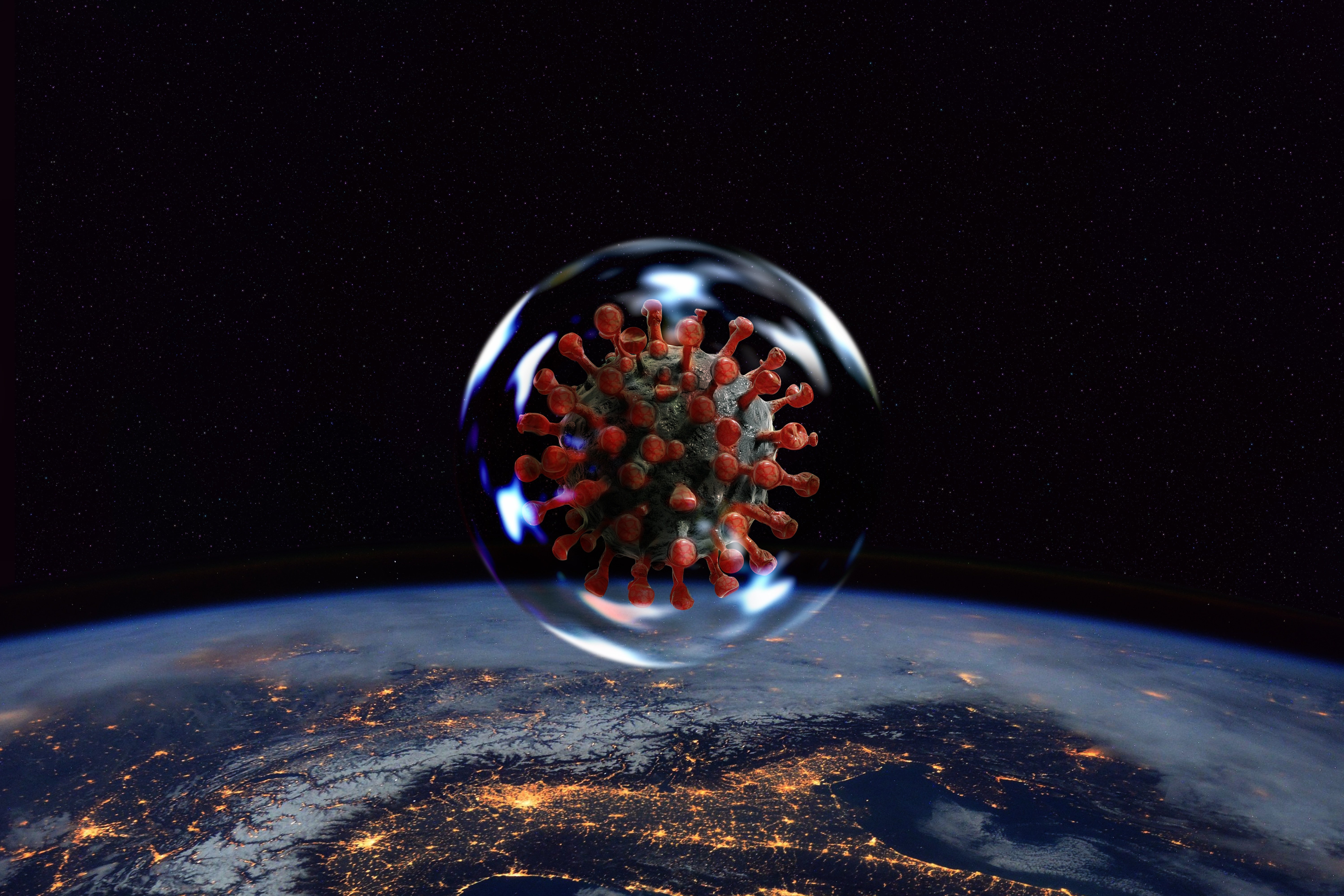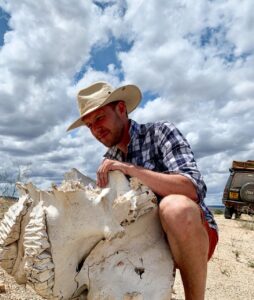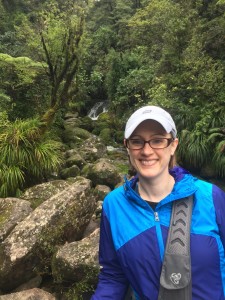
Diseases don’t spread in a vacuum. But as ecologists try to create a more interconnected picture of planet Earth, parasites, viruses and other disease-spreading pathogens have been sidelined. In a new article published May 17 in Nature Ecology and Evolution, a team of scientists makes the case that today, we have the tech and the global connectivity to change that. In this Q&A, we talked with lead author Dr. James Hassell, a wildlife veterinarian, disease ecologist and Keller Family Skorton Scholar with the Smithsonian Conservation Biology Institute’s Global Health Program, and co-author Dr. Katrina Lohan, a parasite and disease ecologist at the Smithsonian Environmental Research Center. Edited for brevity and clarity.

Dr. James Hassell in Tsavo East National Park, Kenya, with the remains of an elephant. (Credit: Francesca Vitali)
Q: We’ve seen how diseases can spill from animals to humans with COVID-19. How big of a threat is disease spillover, even beyond COVID?
James: It’s a major threat. I mean, all the statistics show that the rate at which new diseases are appearing from animals, particularly from wildlife, is increasing. And that’s projected to continue increasing as we keep on coming into closer contact with wildlife, whether that’s through trading wildlife, whether it’s through habitat encroachment….Contact with animals will result in more diseases having the opportunity to cross from animals into people.
Q: The world already has many models looking at the transmission of diseases like COVID-19 or the Ebola virus. What are those models missing?
James: They’re very much focused on a single pathogen. And they’re unable to take into account how those pathogens are interacting with other pathogens or other parasites in the landscape, and also how environmental change is affecting those pathogens mechanistically. So people can create risk maps for the presence of these specific pathogens at a global or at a local scale, but their accuracy is not based on the processes that are occurring in those landscapes.
Katrina: The traditional disease focus has been, you know, you’re looking at one host species and you’re looking at one parasites species and you’re studying that interaction. But that’s not our reality. That’s not realistic in the world that we live in. If we think about humans and, you know, you get food poisoning, there’s so much literature out there about all the bacteria in your microbiome and your gut, right? So it’s not like you are a sterile organism that’s then becoming infected with this pathogen. That’s not the case. We don’t live in a vacuum. We don’t live in a sterile world, and so this really brings it into a more realistic construct.
Q: This kind of big-picture, ecosystem-wide thinking has become more common in ecology. Why haven’t those models included disease more often?
Katrina: Because it’s hard. And it’s really expensive…I also think, though, we are living in a time—as we’re all talking on this Zoom call—where the question now becomes, is the cost higher to do it or to not do it? And I haven’t actually run that math, but I’m going to guess that if we look at the impacts of a pandemic on a global economy, the answer is going to be it’s cheaper to do this than it is to not do it.
Read more: New Model for Infectious Disease Could Better Predict Future Pandemics
Q: Why now? Despite all the obstacles, what makes this kind of disease modeling possible now, as opposed to 10 or 20 years ago?
Katrina: The fact that we live in an era of big data. That we’re growing more and more accustomed to having the computational ability, the types of supercomputers that would be needed to be able to parameterize and run a model like this that wouldn’t take years to finish….We also live in a time when we can sequence an entire community and get all of the different species and/or genes from a community and be able to tease apart relevant information from that data. That technology has only existed since 2007.
James: There’s also a kind of realization that these challenges are global in nature, and that in order to tackle those, there needs to be more collaborative efforts between scientists. And that, along with the availability of funds from more ambitious research programs, means that there is the opportunity to work at far greater scales, which is really what’s important for this model. Because if you’re going to develop a complicated model of ecosystems, you have to be able to collect data and to test it across lots of different sites. And then to do that, you need to have this kind of collaborative, open approach to science, whereby data is shared and people are willing to work together.
Q: About that kind of global cooperation: Is some of this already happening, with the efforts like the Global Virome Project?
James: I think [those initiatives] are important. What they’re targeted on doing is really improving our understanding of diversity. So whether it’s the Global Virome Project, which is about understanding diversity of viruses, whether it’s the Global Parasite Project, understanding diversity of parasites, that’s critical data to be able to inform modeling efforts. But on their own, they don’t allow you to understand how those parasites or those viruses are part of an integrated system
Katrina: Actually, how [James and I] met was through the Smithsonian’s Interconnected Health Initiative, where we’re trying to take that expertise across the Smithsonian and apply it in a “one health” framework. And a lot of that “one health” framework so far has been really focused on humans and wildlife, with environment more off to the side. And where Smithsonian expertise comes into play is actually not on the human health side, but much more so the environmental ecology side and wildlife connections. And so we as a group kind of fill this gap.
Q: We’ve seen how quickly variants of the COVID-19 virus can emerge. How would these models account for evolution, especially with viruses and other microorganisms that can evolve so rapidly?
James: That’s probably the biggest challenge with building these models….This is one of the parts of the model where it’d be really useful to identify the kind of patterns that actually account for evolution. So, relationships that are predictable across different microorganisms and infectious diseases that you can just pre-program into the model. Because, yeah, evolution is very, very complicated.
Katrina: If you think about how long it takes living mammals to have multiple generations and then see a change in allele frequency over time, that can take a long time. For a virus, it can literally happen within a single infection within a person. Because every time the virus infects a new cell, it’s creating opportunities for mutations to arise. So that means that the virus that infects a single host may not be the same virus that that host is then transmitting to the next host.
Q: It sounds like you’re suggesting ecologists try to find general patterns, and perhaps they could predict how fast organisms will evolve, if not exactly what way they will evolve?
James: Precisely, yeah. And throughout these models, an idea that we’re trying to push is that you can use generalizations, relationships, and that’s to be encouraged, if it simplifies the more complex parts of these models and makes them easier to develop.
Q: What else makes you excited or hopeful for what these big-picture disease models can offer?
James: Because you’re constructing these models from the bottom up, you’re able to make predictions about really any group of pathogens within this system… So you could apply it not only to the viruses we’re most worried about, for pandemics, but also to groups of neglected tropical diseases, such as parasitic diseases.
Katrina: You could also use them to look at the best way to conduct aquaculture, or to do agriculture or livestock. You know, what do you need in those communities to increase the health of the animals that you’re trying to keep alive? Even for conservation purposes, right? If you’re reintroducing a species, what do you need that ecosystem to look like?
Q: Last question: Are viruses alive?
Katrina: There’s definitely a debate as to whether or not they are considered alive. I don’t know how philosophical you want to get, but then the question becomes, what is life, right? What makes something alive? And the argument is that because viruses do not have the ability to reproduce on their own, the fact that they have to infect another organism in order to reproduce, is sort of the primary argument I’ve heard as to why they are not considered living creatures. But they clearly do find a mechanism to reproduce.
James: They share a lot of characteristics with living organisms. Like, they can reproduce and they can evolve through natural selection. So yeah, I mean, I think there’s arguments on both sides. It depends who you talk to.


